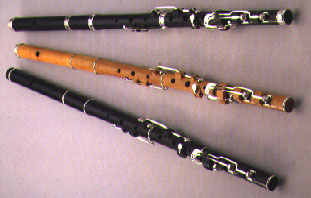http://www.firescribble.net/flute/choosing.html
The first thing to decide is whether you want a simple-system or Boehm-system flute. The vast majority of traditional Irish flute players use a wooden, simple-system flute, like the three flutes shown here, made by Chris Wilkes.

Some people prefer to play Boehm-system flutes, which is the key system on the modern silver flute. The flute shown below is a wooden Boehm-system model made by Chris Abell of Asheville, North Carolina.
Boehm-System Flutes

Billy Clifford of Co. Kerry playing a wooden Boehm-system flute. Photo copyright Peter Laban, Miltown Malbay
Boehm-system flutes are available in metal or wood. They have a cylindrical bore and a complex key system. The renowned German flutemaker and player Theobald Boehm developed this instrument in the mid-1800s because he believed it would make the flute louder and improve its internal tuning, especially in the third octave. These qualities make the Boehm-system flute especially appropriate for classical music in orchestral settings; in fact, by the late 1800s conductors were requiring all orchestra flute players to play Boehm-system instruments.
The fingering of the Boehm system flute is more complex than that of the simple system, making it less popular for traditional Irish music. Plus, without the open holes it is hard to slide from one note to another, which may limit your expressiveness, especially when playing airs.
For more info on the development of the Boehm-system flute, check out the Standing Stones Irish flute site.
Simple-System Flutes
The simple system, conical-bore flute is what people played before Boehm introduced his cylindrical-bore design in the mid-1800s. Simple-system flutes are usually made of wood (cocus, grenadilla [also called African blackwood], rosewood, ebony, and boxwood are the most common), have six tone-holes and anywhere from zero to 13 metal keys. Many experienced Irish flute players prefer six- or eight-key instruments, although much of the traditional Irish repertoire may be played on a keyless flute. The six tone-holes on a simple-system flute correspond to the six holes on a tin whistle: if you already play whistle, you will not need to change your fingering to play the same music on a flute.
Most simple-system flutes used by Irish musicians play in concert pitch: as with a D pennywhistle, the "D" fingering on a flute (six fingers down) produces a D (an octave below that of a pennywhistle) on the A=440 tuning standard in wide use today. People generally refer to these instruments as "concert flutes" or "D flutes" although strictly speaking the latter term is incorrect since the flute may have keys that take it down to C-sharp and C.
As with the whistle, flutes are available in a range of keys. D is standard for Irish music, but you can also find flutes in A, G, F, Eb, C, B, and Bb. These are mostly regarded as novelty instruments, although they do come in handy for certain tunes or for creating a desired mood. By the way, the Bb flute is large, much longer than a standard D flute.You will often come across small "flutes" in the key of Bb, the same size as a Bb whistle; these are called fifes. A small, keyed flute in D, the same size as a D pennywhistle, is known as a piccolo.
The rest of this section of the site deals with factors you should consider in choosing a simple-system flute. Go on to the Next Page to learn about keys, wood, tone, and other considerations.
No comments:
Post a Comment